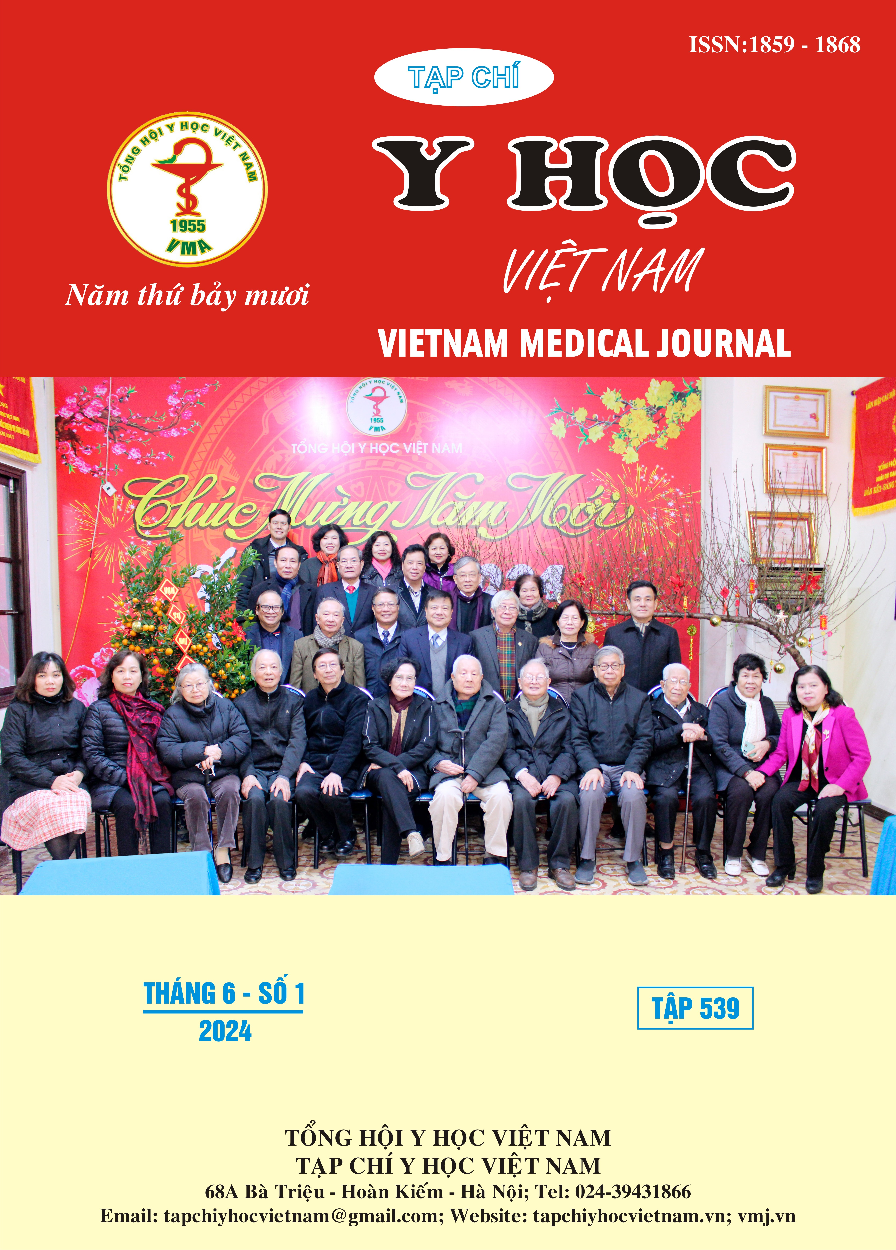CLINICAL AND SUBCLINICAL FEATURES OF PEDIATRIC PATIENTS WITH SACROCOCCYGEAL TERATOMA
Main Article Content
Abstract
Background: Sacrococcygeal teratoma is an extragenital germ cell tumor originating from the coccyx, most of which are benign, but a few can be malignant or have the potential for malignancy. Aims: Describe the clinical and paraclinical characteristics of sacrococcygeal teratoma in children operated on at the national children's hospital from January 2016 to December 2022. Materials and methods: Retrospective study describing all patients diagnosed with sacrococcygeal teratomas, operated on at the general surgery center of the National Children's Hospital, from January 2016 to December 2022. Results: There were 44 patients including 14 male (31.8%) and 30 female (68.2%). The median age of patients was 44.5 days (2-4278 days). There were 17 patients (38.64%) prenatal diagnosis. Common clinical symptoms are sacral mass (100%), 5 patients (11.36%) have urinary incontinence (3 patients with fecal incontinence, 1 patient with urinary incontinence and 1 patient with urinary retention). 2 patients (4.55%) had tumor rupture. Tumor classification according to Altman: Type I 24 patients (54.55%), type II 15 patients (34.09%), type III 5 patients (11.36%), no patients with type IV. Paraclinical symptoms: 11 patients (25%) had alpha-fetoprotein levels higher than their age. The average tumor size on magnetic resonance imaging is 54.45 ± 26.60mm (15-124mm). Most of the tumors are mixed, 27 patients (61.36%), tumors have clear boundaries (40 patients, 90.91%), 4 patients (9.09%) are invasive tumors spinal canal, 2 patients (4.55%) had tumors invade the perineal muscles, 81.82% of sacrococcygeal teratomas were mature teratomas. Conclusion: The clinical symptoms of sacrococcygeal teratoma is the appearance of a mass in the sacrococcygeal region, the incidence is more common in female than male, most are mixed tumors, can be prenatal diagnosed
Article Details
Keywords
Sacrococcygeal teratoma; children
References
2. Hambraeus M, Arnbjörnsson E, Börjesson A, et al. Sacrococcygeal teratoma: A population-based study of incidence and prenatal prognostic factors. J Pediatr Surg. 2016;51(3):481-485. doi: 10.1016/j.jpedsurg.2015.09.007
3. Harms D, Zahn S, Göbel U, et al. Pathology and molecular biology of teratomas in childhood and adolescence. Klin Padiatr. 2006;218(6):296-302. doi:10.1055/s-2006-942271
4. Bedabrata M, Chhanda D, Moumita S, et al. An Epidemiological Review of Sacrococcygeal Teratoma over Five Years in a Tertiary Care Hospital. Indian J Med Paediatr Oncol. 2018; 39(01):4-7. doi:10.4103/ijmpo.ijmpo_239_14
5. Nguyễn Thanh Trúc, Lê Nguyễn Ngọc Diễm, et al. U quái cùng cụt ở trẻ nhũ nhi: Kết quả ngắn hạn. Học TP Hồ Chí Minh. 2018;22(4). July 5; 2022:25-30.
6. Trần Ngọc Sơn. Đánh giá kết quả phẫu thuật điều trị u quái vùng cùng cụt ở trẻ em tại Bệnh viện Nhi Trung ương. Y học Thành Phố Hồ Chí Minh 2016. 2016;(5):180-185.
7. Rattan KN, Singh J. Neonatal sacrococcygeal teratoma: Our 20-year experience from a tertiary care centre in North India. Trop Doct. 2021 ;51(2):209-212. doi:10.1177/0049475520973616.
8. Akinkuotu AC, Coleman A, Shue E, et al. Predictors of poor prognosis in prenatally diagnosed sacrococcygeal teratoma: A multiinstitutional review. J Pediatr Surg. 2015; 50(5): 771-774. doi: 10.1016/ j.jpedsurg. 2015.02.034
9. Kops AL, Hulsker CC, Fiocco M, et al. Malignant recurrence after mature Sacrococcygeal teratoma: A meta-analysis and review of the literature. Crit Rev Oncol Hematol. 2020;156: 103140. doi:10.1016/j. critrevonc. 2020.103140
10. Hassan HS, Elbatarny AM. Sacrococcygeal teratoma: management and outcomes. Ann Pediatr Surg. 2014;10(3): 72-77. doi:10.4314/ aps.v10i3


